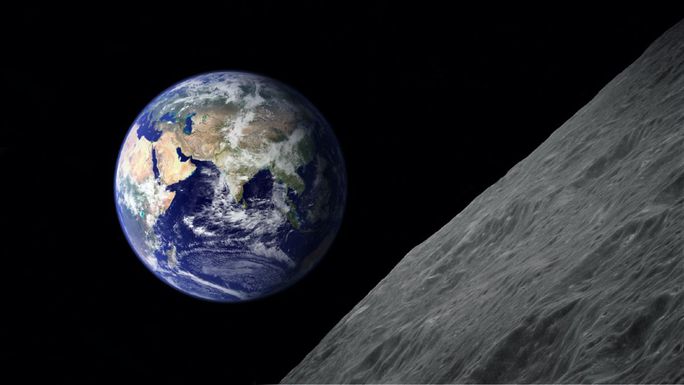According to Live Science, the moon's orbit around Earth seems so regular that some civilizations relied on its movements to calculate the days and months. However, modern science shows that it is gradually moving away from the Earth, causing the world's oceans to expand.
Scientists have determined the speed at which the Moon drifts away from Earth using reflectors that NASA placed on the celestial body during the Apollo missions.
Earth seen from the Moon - Photo: Jeremy Horner
For more than 50 years, laser beams from Earth have been aimed at them, and the reflected pulses have been recorded, helping NASA estimate that the asteroid is drifting away from Earth by about 3.8 centimeters per year.
This is only about the speed at which human fingernails grow, but the cumulative distances over the extremely long lifetimes of astronomical objects pose a real problem.
The Earth's oceans are bulging toward the Moon due to its gravitational pull on the tides. In turn, our "sister Moon" is gradually taking on an oval shape as it is also stretched by the Earth's gravitational interaction.
Astrophysicist Madelyn Broome from the University of California at Santa Cruz (USA) said that about 4.5 billion years ago, when the Moon was newly formed, the Earth's rotation speed was significantly faster, the length of a day was only about 5 hours.
The Moon was also much closer to Earth at that time, and the two celestial bodies were constantly interacting with each other. The gravitational force from the Earth's tidal bulge affected the Moon; conversely, the oceans moving due to the Moon's gravitational force also created friction on the Earth's surface, slowing its rotation.
Since the Earth and the Moon are part of a gravitationally interacting system, the angular momentum of the entire system must be conserved. Angular momentum (also called rotational momentum) represents the energy contained in something that is rotating. The faster the rotation and the farther apart the two objects are rotating, the more energy they have, and vice versa.
So as the Earth slowed down—and the Moon itself slowed down in the past—the two bodies must have balanced the angular momentum of the system by moving away from each other. The Moon took the blame.
The Moon has stopped rotating slowly today, because it has officially stopped rotating on its own for a long time and is "tidally locked" to Earth, meaning that only one side is facing our planet.
Models suggest that Earth eventually chose to "tuck in" to the Moon by also tidally locking itself, facing the Moon with a single side so that the Moon would not have to recede any further.
This will happen in the next 50 billion years, according to Dr. Jean Creighton, Director of the Manfred Olson Planetarium from the University of Wisconsin-Milwaukee and Professor Eric Klumpe from Middle Tennessee State University (USA).
Unfortunately, their parent star - the Sun - will run out of energy and evolve into a red giant before collapsing into a white dwarf in about 5 billion years.
As it swells into a red giant, the Sun is predicted to engulf several nearby planets — including their moons, of course.
The Earth is on the list of "swallowed", according to the calculations. That means both the Moon and the Earth will disappear much sooner than they decide to stop spinning together.
Source NLDO
Source link




![[Photo] Vietnamese and Hungarian leaders attend the opening of the exhibition by photographer Bozoky Dezso](https://vphoto.vietnam.vn/thumb/1200x675/vietnam/resource/IMAGE/2025/5/29/94d8ceca5db14af3bf31285551ae4bb3)
![[Photo] Prime Minister Pham Minh Chinh meets with Hungarian President Sulyok Tamas](https://vphoto.vietnam.vn/thumb/1200x675/vietnam/resource/IMAGE/2025/5/29/dbcaa73e92ea4448a03fe1d0de6d68e8)



















![[Photo] Prime Minister Pham Minh Chinh receives a bipartisan delegation of US House of Representatives](https://vphoto.vietnam.vn/thumb/1200x675/vietnam/resource/IMAGE/2025/5/28/468e61546b664d3f98dc75f6a3c2c880)
































































Comment (0)